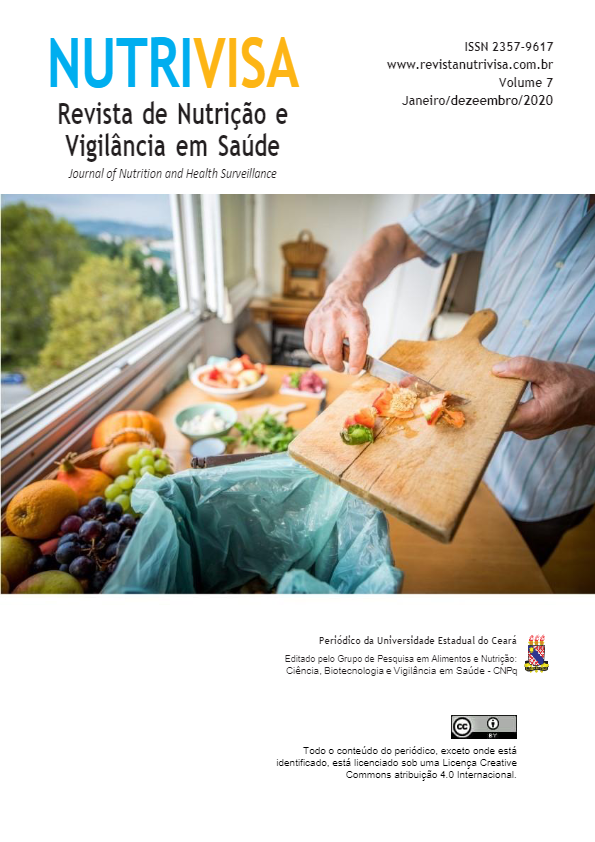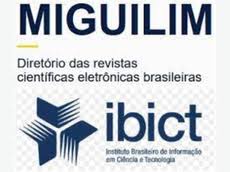Contaminação microbiológica de fórmulas infantis: uma revisão sistemática
DOI:
https://doi.org/10.59171/nutrivisa-2020v7e9975Palavras-chave:
Lactente, Microbiologia de alimentos, Fórmula InfantilResumo
O presente trabalho tem por objetivo descrever os micro-organismos envolvidos na contaminação de Fórmulas Infantis (FI), através de uma revisão sistemática, envolvendo a investigação minuciosa de múltiplos artigos primários, para uma posterior análise e seleção de todos os artigos relevantes à busca em questão. Os resultados obtidos permitem observar que a contaminação de FI envolve diversos micro-organismos, sendo o mais identificado nas análises, o Cronobacter sakazakii, além de Coliformes totais, Salmonella spp, Staphilococcus aureus, bactérias estas de elevada patogenicidade, e portanto associadas à morbimortalidade infantil. As informações obtidas permitem concluir que, As análises microbiológicas em FI são muito importantes, uma vez que fornecem dados sobre a qualidade da dieta ministrada a uma população naturalmente vulnerável, em casos de surtos alimentares, por exemplo, é possível constatar se há relação com o alimento, ou não, verificar onde houve falha, permitindo a contaminação, e ainda possibilita o emprego de medida corretiva adequada para evitar novos casos.
Referências
ABRANTES V. R. S.; TABAI K. C. Fórmulas para o público infantil: A promoção comercial nas rotulagens e sua adequação com a legislação vigente. Revista Brasileira de Economia Doméstica, v. 24, p. 021-037, Viçosa, 2013.
ALMEIDA J. A. G. Amamentação um híbrido natureza-cultura. Editora FIOCRUZ, p.58-59, Rio de Janeiro, 1999.
ANVISA (AGÊNCIA NACIONAL DE VIGILÂNCIA SANITÁRIA.). RESOLUÇÃO DA DIRETORIA COLEGIADA – RDC Nº 43, DE 19 DE SETEMBRO DE 2011. Disponível:<http://portal.anvisa.gov.br/documents/33916/394219/RDC%2B43%2Balt erada%2Bpela%2B46_2014%2Bok.pdf/faef9da8-6701-414b-b74c-c3cb61a49371>. Acesso em: 24 de julho, 2018.
ARCURI et al. Contagem, isolamento e caracterização de bactérias psicrotróficas contaminantes de leite cru refrigerado. Ciência Rural, Santa Maria, v.38, n.8, p.2250-2255, nov, 2008.
BRANDÃO D. S.; VENANCIO S. I.; GIULIANE E. R. J. Associação entre a implantação da Rede Amamenta Brasil e indicadores de aleitamento materno. Jornal de pediatria, v. 9, p. 143-151, Rio de janeiro, 2015.
FEI P. Et al. Genotyping and Source Tracking of Cronobacter sakazakii and
C. malonaticus Isolates from Powdered Infant Formula and an Infant Formula Production Factory in China. Applied and Environmental Microbiology, V. 81, p. 5430 –5439, 2015.
FERREIRA L., PARADA C. M. G. L., CARVALHES M. A. B. L. Tendência do aleitamento materno em município da região centro-sul do estado de São Paulo: 1995-1999-2004. Rev. Nutr., Campinas, v. 20, p. 65-273, maio/jun., 2007.
FORSYTHE S. j. Microbiologia da segurança dos alimentos. Artmed editora LTDA. 2013. 2ª edição.
FLORES J. P. et al. Two Cases of Hemorrhagic Diarrhea Caused by Cronobacter sakazakii in Hospitalized Nursing Infants Associated with the Consumption of Powdered Infant Formula. Journal of Food Protection, V. 74, p.
-2181, 2011.
FRANCISQUINI J. D. et al. Efeito do tratamento térmico sobre fórmulas infantis: Uma revisão. Rev. Inst. Laticínios Cândido Tostes, v. 72, n. 4, p. 236-244, Juiz de Fora, 2017.
GIBSON S. et al. Unfit for human consumption’: a study of the contamination of formula milk fed to young children in East Java, Indonesia. Tropical Medicine and International Health, v. 22, p. 1275 – 1282, 2017.
HENEKINNE R. B. et al. Survival of Cronobacter in powdered infant formula and their variation in biofilm formation. Latters in applied microbiology, v. 66, p. 496-505, 2018.
HINDS L. M. Effect of Infant Formula on Streptococcus Mutans Biofilm Formation. Journal of Clinical Pediatric Dentistry, V. 40, p. 178-185, 2016.
HOQUE A. et al. Isolation and molecular identification of Cronobacter spp. from powdered infant formula (PIF) in Bangladesh. International Journal of Food Microbiology, v. 142, p.375-378, 2010.
JACKSON E. E. et al. Reevaluation of a Suspected Cronobacter sakazakii Outbreak in Mexico. Journal of Food Protection, V. 78, p. 1191-1196, 2015.
JANG H. I.; RHEE M. S. Inhibitory effect of caprylic acid and mild heat on Cronobacter spp. (Enterobacter sakazakii) in reconstituted infant formula and determination of injury by flow cytometry. International Journal of Food Microbiology V. 133, p. 113-120, 2009.
LAMOUNIER J. A. et al. Iniciativa Hospital Amigo da Criança, mais de uma década no Brasil: repensando o futuro. Rev Paul Pediatr , v. 26, p. 161-1692008.
LI Z. et al. Prevalence and Characterization of Cronobacter sakazakii in Retail MilkBased Infant and Baby Foods in Shaanxi, China. Foodborne Pathogens and Disease, v. 13, 2016.
LINHARES I. W. Avaliação das condições higiênico - sanitárias no preparo de fórmulas infantis em lactário hospitalar. Dissertação de mestrado, Belo Horizonte, 2012.
MAIA P. R. S. et al. Rede Nacional de Bancos de Leite Humano: gênese e evolução. Rev. Bras. Saúde Matern. Infant., v. 6, p. 285-292, jul. / set., Recife, 2006.
MAIESKI L. M. Os principais micro-organismos patogênicos que afetam a qualidade do leite. Monografia, Porto Alegre, 2011.
MELO C. S., GONÇALVES R. M. Aleitamento materno versus aleitamento artificial. Revista de estudos ambientais e saúde, v. 41, especial, p. 7-14, out, Goiânia, 2014.
MENDONÇA M. A. Fórmulas infantis para lactentes: Perfil lipídico e características físicas dos glóbulos de gordura. Tese de Doutorado/Programa de Pós-Graduação em Nutrição Humana da Universidade de Brasília. Brasília, 2016.
MINISTÉRIO DA SAÚDE (MS). Prevalência de aleitamento materno. Brasília-DF, 2012. Disponível em: <http://tabnet.datasus.gov.br/cgi/idb2012/g13_08.htm>. Acesso em: 20 de junho, 2018.
MINISTÉRIO DA SAÚDE (MS). Aleitamento materno, distribuição de leites e fórmulas infantis em estabelecimentos de saúde e a legislação. Brasília-DF, 2014. Disponível em: <http://bvsms.saude.gov.br/bvs/publicacoes/aleitamento_materno_distribuicao_leite. pdf>. Acesso em: 16 de julho, 2018.
MINISTÉRIO DA SAÚDE (MS). AGÊNCIA NACIONAL DE VIGILÂNCIA SANITÁRIA (ANVISA). RESOLUÇÃO-RDC Nº 171, DE 4 DE SETEMBRO DE 2006. Disponível em: <http://portal.anvisa.gov.br/documents/33880/2568070/res0171_04_09_2006.pdf/08 6680c6-2a27-4629-ba6f-f4f41cef14c3>. Aceso em: 14 de setembro, 2018.
MINISTÉRIO DA SAÚDE (MS). AGÊNCIA NACIONAL DE VIGILÂNCIA SANITÁRIA (ANVISA). RESOLUÇÃO - RDC Nº 360, DE 23 DE DEZEMBRO DE 2003. Disponível em: <http://portal.anvisa.gov.br/documents/33880/2568070/res0360_23_12_2003.pdf/5d 4fc713-9c66-4512-b3c1-afee57e7d9bc>. Acesso em: 2 de junho, 2018.
MINISTÉRIO DA SAÚDE (MS). AGÊNCIA NACIONAL DE VIGILÂNCIA SANITÁRIA (ANVISA). RESOLUÇÃO-RDC Nº 12, DE 2 DE JANEIRO DE 2001. Disponível em: . Acesso em: 10 de junho, 2018.
MOMESSO N. N. et al. Estudo da contaminação microbiana no preparo de fórmulas l ácteas infantis em lactário de um hospital universitário do Sul de Minas Gerais. Revista Ciências em Saúde, v6, n 3, 2016.
NIENOV et al. Qualidade higiênico-sanitária de formulações ministradas a neonatos.. rev. Soc. Bras. Alim. Nutr.= J. Brazilian Soc. Food Nutr., v. 34, p. 127-138, São Paulo, 2009.
PAIVA et al. Qualidade microbiológica da água utilizada na reconstituição de fórmulas infantis utilizadas em unidades hospitalares pediátricas da rede privada na cidade de Rio de Janeiro. Revista Semioses, v 10, 2016.
PAN Z. et al. Isolation and molecular typing of Cronobacter spp. in commercial powdered infant formula and follow-up formula. Foodborne Pathogens and Disease, V.11, 2014.
PASSANHA A.; MANCUSO A. M. C.; SILVA M. E. M. P. Elementos protetores do leite materno na prevenção de doenças gastrintestinais e respiratórias. Rev. bras. crescimento desenvolv. hum. V 20 n.2 São Paulo agosto, 2010.
PENTERICH V. R. A., ATZINGEN M. C B. C. V., SILVA M. E. M. P. Determinação da viscosidade e composição nutricional de uma fórmula infantil à base de hidrolisado p rotéico de frango. Pediatria (São Paulo), São Paulo, v. 32, n. 2, p. 106-112, 2010.
REGO J. D. Aleitamento Materno. Editora Atheneu. 2009. 2ª edição.
RÊGO C. Leites e Fórmulas Infantis: a realidade portuguesa revisitada em 2012. Acta Pediatr Port. V. 44, p. 50-93, 2013.
REGINATO A. et al. Qualidade microbiológica de fórmulas infantis administradas em hospital público do município de Campinas, São Paulo. Segurança Alimentar e Nutricional, v. 2, p. 387-394, Campinas, 2014.
RIBEIRO S. P.; RUFINO L. R. A.; OLIVEIRA R. B. S. Avaliação das condições higiênico sanitárias de um lactário de Minas Gerais. Higiene Alimentar - V.30 , p. 60-61, 2016.
ROSSI P. Avaliação de perigos microbiológicos no preparo de fórmulas infantis em lactário hospitalar. Tese de mestrado, Campinas, SP, 2007.
ROSSI P., KABUKI D. Y., KUAYE A. Y. Avaliação microbiológica do preparo de fórmula láctea infantil em lactário hospitalar. Rev. Inst. Adolfo Lutz (Impr). vol.69, p. 503 – 509, São Paulo, 2010.
SÁEZ M.; LLANOS F.; TAMAYO R. Primer aislamiento de Cronobacter spp (Enterobacter sakazakii) en fórmula láctea en polvo producida en Chile / First isolation of Cronobacter spp (Enterobacter sakazakii) in powdered baby formula in Chile.
Revista Chilena de Salud Pública, v. 16, p. 11-15. 2012.
SANI N. A.; HARTANTYO S. H. P.; FORSYTHE S. J. Microbiological assessment and evaluation of rehydration instructions on powdered infant formulas, follow-up formulas, and infant foods in Malaysia. Journal of Dairy Science, V. 96, P. 1-8, 2013.
SANTOS A. C. S. et al. Microbiological quality of enteral feeding and infant formula produced in dietary units, according to the triad of Donabedian. Nutr Hosp., V. 31, P. 2122-2130, 2015.
SANTOS R. F. S. et al. Screening for Cronobacter species in powdered and reconstituted infant formulas and from equipment used in formula preparation in maternity hospitals. Ann Nutr Metab., v. 63, p. 62-68, 2013.
SILVA et al. Composição centesimal do leite humano e caracterização das propriedades físico-químicas de sua gordura. Rev. Quim. Nova, v. 30, p. 1535-1538, São Paulo, 2007.
SOUZA C. P. Segurança alimentar e doenças veiculadas por alimentos: Utilização do grupo coliforme como um dos indicadores de qualidade de alimentos. Revista APS, v.9, p. 83-88, 2006.
SUCENA L. P.; FURLAN M. F. Incidência da utilização de leite materno ordenhado em uma Unidade de Terapia Intensiva neonatal e caracterização dos recém nascidos. Arq Ciênc Saúde, V.15, P. 82-89, 2008.
SCHANLER R. J. Em tempo: leite humano é a estratégia alimentar para prevenir a enterocolite necrosante. Revista Paulista de Pediatria, v. 33, p. 131-133, São Paulo.
SHI C. et al. Inactivation of Nondesiccated and Desiccated Cronobacter sakazakii in Reconstituted Infant Formula by Combination of Citral and Mild Heat. Journal of Food Protection, V. 80, p. 1193-1197.
VIANA M. A. F. A importância do aleitamento materno exclusivo. Monografia, Brasília, 2017.
XU X. et al. Occurrence and Characterization of Cronobacter spp. in Powdered Formula from Chinese Retail Markets. Foodborne Pathogens and Disease, v. 11, 2014.
WANG X. et al. Characterization of Staphylococcus aureus isolated from powdered infant formula milk and infant rice cereal in China. International Journal of Food Microbiology , V. 153, p.142-147, 2012.
YANG B. et al. Prevalence and characterizationof Salmonella enterica in dried milkrelated infant foods in Shaanxi, China. Journal of Dairy Science, v. 97, p. 67546760, 2014.
YANG Y. et al. Multilocus sequence type profiles of Bacillus cereus isolates from infant formula in China. Food microbiology, v. 62, p. 46-50, 2017.
ZHOU B. et al. A new application of a sodium deoxycholate-propidium monoazidequantitative PCR assay for rapid and sensitive detection of viable Cronobacter sakazakii in powdered infant formula. Journal of Dairy Science, v. 99 , p. 9550-9559, 2016.
Downloads
Publicado
Como Citar
Edição
Seção
Licença
Copyright (c) 2020 Hosana da Silva Santos

Este trabalho está licenciado sob uma licença Creative Commons Attribution 4.0 International License.














